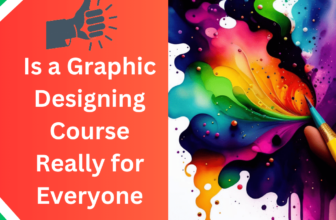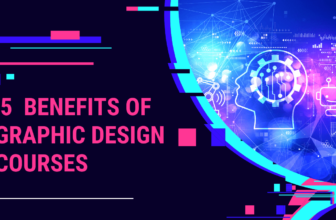
In a world driven by visual storytelling, graphic design has become a crucial skill. Whether it’s launching a brand, promoting a cause, or simply engaging an audience, the role of graphic design is omnipresent. This article meticulously evaluates two avenues for becoming proficient in graphic design: formal educational courses and self-taught endeavors. So we thought we’d give you some guidance on Graphic Designing Course vs Self-Taught.
Table of Contents
Why is Graphic Design Important?
Role in Different Industries
From being limited to the arts and entertainment sectors, graphic design has permeated many industries. From healthcare to real estate and technology startups to nonprofit organizations, graphical design application is as varied as it is vast. In essence, it serves as the linchpin for any visual communication strategy. So we thought we’d give you some guidance on Graphic Designing Course vs Self-Taught

Influence on Public Perception
We often underestimate the formidable influence of graphic design on shaping public perception. The psychology of color, form, and typography can dramatically alter consumer behavior and opinion. This tacit power renders graphic design an art or skill and a compelling record of persuasion.
- Gearing Up for a Career in Graphic Design
- Required Skills
Technical Abilities
A proficient graphic designer needs to master various technical skills, from Adobe Creative Suite applications like Photoshop and Illustrator to principles of color theory and typography. Proficiency in design software is not a luxury—it’s a necessity.
Soft Skills
Beyond the technical arena, intrinsic traits like creativity, problem-solving, and adaptability are invaluable. Effective communication and time management are often underestimated but can be the differentiating factors in a competitive market.
- Importance of a Portfolio
Creating Your First Portfolio
Building a portfolio is not just a one-off event; it’s an evolving showcase of your capability. Every piece adds a new dimension to your skill set, from student projects to freelance assignments. So we thought we’d give you some guidance on Graphic Designing Course vs Self-Taught.
Case for Quality Over Quantity
While it may be tempting to inundate your portfolio with myriad works, curators and employers seek quality over quantity. A well-crafted portfolio with select projects demonstrating your versatility and prowess will invariably be more impressive than a voluminous but mediocre collection.
- The Case for Graphic Designing Courses
- Types of Courses
Bachelor’s Degrees
These are four-year programs often incorporating a holistic overview of art and design.
Certificate Programs
These are more targeted, shorter in duration, and often focus on skill-specific training.
Online Courses
Digital courses offer both flexibility and a diverse curriculum but require high self-motivation.
- Advantages
Structured Learning
Courses offer a planned curriculum, frequently updated to reflect industry standards.
Networking
Academic environments foster connections that can lead to internships, partnerships, or job opportunities.
Career Services
Many institutions provide career placement services, including portfolio reviews and job listings.
- Disadvantages
Time Commitment
Courses, especially degree programs, require a substantial time investment that might only be feasible for some.
Cost
The financial burden of a formal education can be prohibitive for some.
Potential for Outdated Curriculum
The rapid evolution of design tools and trends may outpace academic curriculums.
- Selecting the Right Course
Accreditation
Ensure the program is accredited by a reputable body.
Syllabus
Examine the curriculum meticulously to ensure it aligns with your career goals.
Faculty Credentials
Faculty experience in academia and industry is a pivotal factor in your education.
- The Self-Taught Journey
- Available Resources
Online Tutorials
The internet is replete with tutorials that cover an extensive array of subjects.
Essential Reads
Books like “Don’t Make Me Think” by Steve Krug offer invaluable insights.
Social Media Groups
Online communities can provide networking opportunities and ongoing support.
- Advantages
Flexibility
Learn anytime, anywhere, at your own pace.
Cost-Effective
Many resources are free or comparatively less expensive.
Learn at Your Own Pace
You set your timeline and learning objectives.
- Disadvantages
Unstructured Learning
The absence of a structured curriculum can lead to gaps in knowledge.
No Formal Certification
Lack of a formal degree may hinder some employment opportunities.
Potential for Gaps in Knowledge
The fragmented nature of self-guided learning can result in an uneven skill set.
- Comparative Evaluation
- Curriculum Comparison
Course vs. Self-Directed Learning
While courses offer structured learning, self-taught routes provide the freedom to focus on specific interests. So we thought we’d give you some guidance on Graphic Designing Course vs Self-Taught
- Financial Considerations
Cost-Benefit Analysis Graphic Designing Course vs Self-Taught
Courses may offer more comprehensive resources and networking at a higher cost. At the same time, self-learning is more budget-friendly but may require more time for the same level of proficiency. So we thought we’d give you some guidance on Graphic Designing Course vs Self-Taught
- Time Investment
Time to Proficiency
Courses often come with defined timelines, whereas self-learning is more malleable but might lead to extended durations for mastery.
- Employment Prospects
Job Market Reception
A formal degree may open doors to larger corporations or specialized fields. A strong portfolio can sometimes offset the need for proper credentials.
Choosing between a formal graphic design course and a self-taught journey is not straightforward; it’s a multidimensional equation that depends on your time, resources, and career goals. Careful consideration and introspection are essential to charting the path that best suits you. So we thought we’d give you some guidance on Graphic Designing Course vs Self-Taught
Conclusion
Choosing a path in graphic design is a significant decision that depends on multiple factors like time, resources, and career goals. Whether you opt for a formal graphic designing course or embark on a self-taught journey, each has unique advantages and setbacks. On the other hand, self-taught options provide flexibility and are cost-effective, but they can leave gaps in your skillset. So we’ve given you some guidance on whether to take a graphic designing course versus being self-taught.
Why is graphic design important in different industries?
Graphic design is not just for arts and media. It’s also vital in healthcare, real estate, tech, and nonprofits. It helps with visual communication across fields.
What skills do I need to be a graphic designer?
You’ll need both technical and soft skills. For example, you should know how to use design software like Photoshop. But you also need creativity and good time management.
What’s the difference between a degree and an online course?
A degree is usually a four-year program and gives you a broad view of art and design. An online course is more flexible and often focuses on specific skills.
Is a formal education better than self-teaching for graphic design?
Both have pros and cons. Formal education offers structured learning and career services. Self-teaching is more flexible and cost-effective but may leave gaps in your knowledge.
How important is a portfolio in a graphic design career?
Very important. A portfolio shows off your skills and quality of work. It’s your career’s showcase and is often more important than a formal degree.







